A showcase project for achieving "Quality Growth"—a pillar of JICA's mission—has been implemented in India. The new transportation infrastructure in the nation' s capital, Delhi, has changed the working styles and lifestyles of its population, and that change is set to spread to other cities as well as other countries.
The lifestyles of citizens have changed greatly
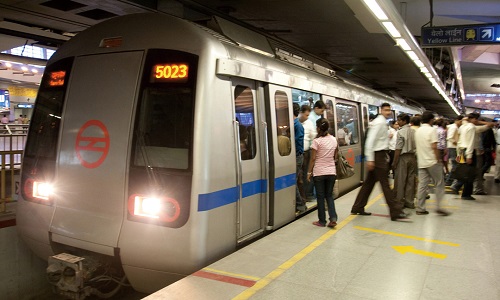
Delhi Metro stations are kept very clean. On top of that, the trains run on time from early in the morning until late at night, which is comparable to Japan.
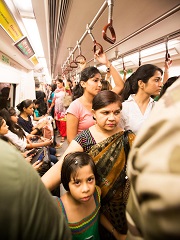
A women-only car on the Delhi Metro. It has become easier for women to work in the city because they can now commute with peace of mind.
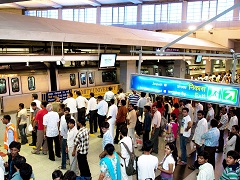
The scene of passengers lining up for the train is just like that of Japan. A barrier-free design is also promoted at stations.
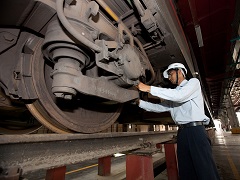
When constructing railways, maintenance is considered a difficult aspect. The know-how of Japanese companies is being leveraged in this regard.
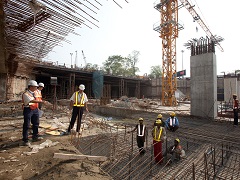
The implementation of safety measures at construction sites spread steadily as projects were carried out. Today they are carried out as a matter of course.
Women also play active roles in Delhi Metro operations
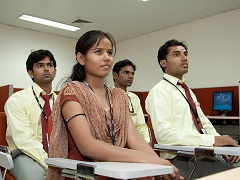
India still has a reputation for gender inequality, but Delhi Metro Rail Corporation is promoting the creation of workplaces that are also pleasant for women.
Massive subway network built over a period of about 20 years
Delhi continues to experience rapid economic growth. At the same time, it has been plagued with chronic traffic congestion. The Delhi Metro (Delhi Mass Rapid Transport System) was constructed to eliminate that congestion. Since commencing operations in 2002, it has grown to a total length of 317 kilometers (as of November 2018), making it longer than the Tokyo Metro, which extends 195 kilometers. Through ODA loans, Japan has continued to provide support for the development of the Delhi Metro since its planning stage in 1995.
At that time in India, substantial delays in infrastructure construction were commonplace. However, with the Delhi Metro, there were some sections that were even completed ahead of schedule, and over the course of approximately 20 years, a massive urban transportation network has became operational. This was the result of strong leadership on the part of Elattuvalapil Sreedharan, who was Delhi Metro Rail Corporation's first Managing Director, and the earnest problem-solving efforts of Delhi Metro employees and Japanese consultants involved in construction. Shohei Hara, Director General of JICA's South Asia Department, has this to say about Sreedharan and his achievements, "He had excellent judgment as a professional civil engineer; he immediately adopted the proposals of Japanese consultants if he agreed with them. Those involved in the construction work, both in Japan and India, know that Delhi Metro would not have been a success if it weren't for him."
India already had a huge nationwide railway network, but there was not necessarily a high awareness of safety during construction. For example, it was not common for helmets and safety shoes to be worn on construction sites, and safety rules for clothing were not widely practiced. Construction sites were also not fenced in, and it was common to have non-related individuals enter the premises. Together with Japanese consultants, JICA actively encouraged their Indian counterparts to engage in safety management and make thorough use of safety equipment and fences. These safety measures have now been adopted in the construction of metro systems outside of Delhi and have spread all over India.
At first, those involved on the Indian side questioned the importance of carefully and thoroughly handling land acquisition and resident relocation according to the JICA Guidelines for Environmental and Social Considerations, saying, "Why do we have to go that far? Wouldn't it be easier to meet the deadline if we proceed more quickly?" However, JICA was able to obtain their understanding by continuing to explain that gaining the consent of residents and minimizing the impact on them are basic principles of public works, and that this also prevents construction delays and leads to earlier realization of development outcomes.
Delhi Metro innovations spread to other cities and countries
The Delhi Metro greatly changed the lifestyles of a population that had previously relied upon buses and rickshaws as primary forms of transportation. They were constantly affected by traffic congestion, and there were also concerns about accidents and crime. The Delhi Metro, on the other hand, runs on time from 6:00 a.m. to around 11:00 p.m., has air conditioning for comfort, and also women-only cars, providing safe and reliable transportation. At 10 rupees (approx. 16 yen), the base fare is a little higher than that of buses, but the number of passengers is steadily increasing. Additionally, those who had previously been unfamiliar with the custom of standing in line have learned to board the train in an orderly fashion, queueing behind the lines drawn on the platforms and following the instructions of station staff. Urban railway development has also brought about a change in the behaviour patterns of Indian people. Hara explains, "JICA has provided cooperation not only with funding to physically build the railway, but also with the adoption of safety measures and influencing society after its completion. This has produced tremendous results, in part because it coincided with the timing of social change within India."
Thanks to these experiences, Delhi Metro Rail Corporation employees are now acting as consultants. Based on the know-how they gained from Japan, they are working on the construction of urban railways throughout India, as well as in other countries such as Bangladesh and Indonesia.
The innovation that has taken place with the Delhi Metro has contributed to the development of new human resources and "quality growth" that goes beyond infrastructure development. It is expected to continue its impact in various ways on cities in need of such changes.




scroll